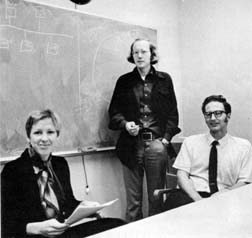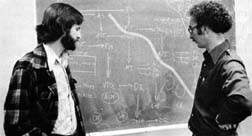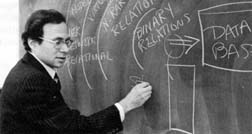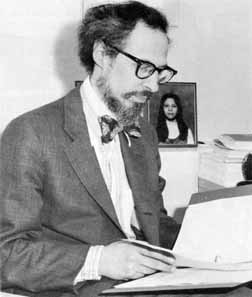
 |
 Professors Liba Svobodova (left), Jerome H. Saltzer (right), and Dr.
David D. Clark formulate research plans in computer systems
research. Professor Svobodova's interests are in measurement and
evaluation of computer system performance in distributed
processing, and in computer architecture. Professor Saltzer, who
heads this large research group, is interested in the engineering of
large-scale computer systems; in the protection of information
within computers and computer networks; and in data
communications. Dr. Clark's interests are in the structure of
computer operating systems; in Input-Output processes and in
computer communications, networks, and distributed computer
systems.
Professors Liba Svobodova (left), Jerome H. Saltzer (right), and Dr.
David D. Clark formulate research plans in computer systems
research. Professor Svobodova's interests are in measurement and
evaluation of computer system performance in distributed
processing, and in computer architecture. Professor Saltzer, who
heads this large research group, is interested in the engineering of
large-scale computer systems; in the protection of information
within computers and computer networks; and in data
communications. Dr. Clark's interests are in the structure of
computer operating systems; in Input-Output processes and in
computer communications, networks, and distributed computer
systems.
 Professor David D. Redell (left) is interested in computer system
architecture; software engineering; system implementation
languages; and in privacy, security and protection in information
systems.
Professor David D. Redell (left) is interested in computer system
architecture; software engineering; system implementation
languages; and in privacy, security and protection in information
systems.
Professor Michael D. Schroeder is interested in computer system structure and organization; timesharing; protection mechanisms; system programming languages; and the correctness of systems.
 Professor Stuart (Stu) E. Madnick of the Sloan School of Management
and an affiliate member of the Laboratory, is interested in
information systems, computer architecture and database systems.
Professor Stuart (Stu) E. Madnick of the Sloan School of Management
and an affiliate member of the Laboratory, is interested in
information systems, computer architecture and database systems.
 Professor Fernando J. Corbató (Corby), Associate Head of the
Department of Electrical Engineering and Computer Science, is a
pioneer in the area of timeshared systems. In 1961, he headed the
development of one of the world's first such systems—the
Compatible Time-Sharing System (CTSS)--and its considerably
improved successor--the Multics time-sharing system (1967).
Professor Fernando J. Corbató (Corby), Associate Head of the
Department of Electrical Engineering and Computer Science, is a
pioneer in the area of timeshared systems. In 1961, he headed the
development of one of the world's first such systems—the
Compatible Time-Sharing System (CTSS)--and its considerably
improved successor--the Multics time-sharing system (1967).
The Laboratory's research and development in timesharing systems gave rise to many direct results such as virtual memory, the writing of a complex system such as Multics in a higher-level language (PL/1), and several novel approaches for privacy and protection of information. In addition, the community of users of these systems during the last 12 years has given rise to many indirect results such as the development of application programs and the realization that time-sharing systems are best suited for sharing information rather than simply sharing hardware resources.
 This 1975 MIT Lab for Computer Science
Brochure was reconstructed in HTML by Peter
Szolovits, 1995.
This 1975 MIT Lab for Computer Science
Brochure was reconstructed in HTML by Peter
Szolovits, 1995.
Back to MIT Laboratory for Computer Science 1975 index page
Please send site comments to our Webmaster.
Please see our notices about the content of this site and its usage.
(cc) 1998-
Digibarn Computer Museum, some rights reserved under this Creative Commons license.